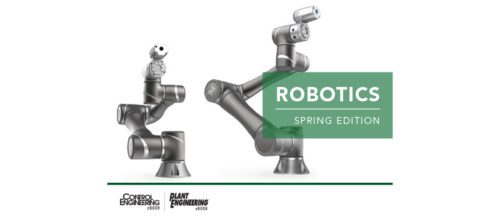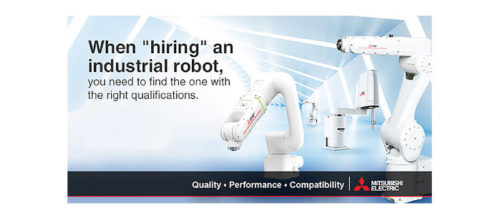Manufacturers can do a better job of planning for the future
Digital Edition Exclusive: A futurist said manufacturers could do a better job of planning, to lower risk and increase opportunities to gain competitive advantage. Proliferation of robotics, 3D printing, demographic changes, climate change, and government debt are among under-anticipated high-impact trends, suggested Richard Worzel, author of “Who Owns Tomorrow?” during his presentation at the online 2014 ABB Automation and Power World conference.
Proliferation of robotics, 3D printing, demographics, climate change, and government debt are among under-anticipated high-impact trends, suggested Richard Worzel, author of "Who Owns Tomorrow?" Worzel, futurist and chartered financial analyst (CFA), described himself as more of a planner than a prophet. He said manufacturers could do a better job of planning, to lower risk and increase opportunities to gain competitive advantage, during the online 2014 ABB Automation and Power World conference.
His was among 25 presentations at the June 4 online conference; ABB said it would resume an in-person conference in 2015.
Planning with a futurist
A futurist, Worzel explained, is someone who looks at available information in an organized, systemized manner to prepare for uncertainty. He makes a living by studying, planning, and preparing for the future. "I am a planner, not a prophet," he said. Planning helps companies to improvise with greater intelligence.
He noted that many companies and governments lack imagination in planning for the future. "How will tomorrow differ from today?" Worzel asked.
Many forecasters expected something like Superstorm Sandy to happen, he explained, yet there was little preparedness or planning by authorities, businesses, or individuals, which caused more suffering, economic cost, and lost opportunities than were necessary.
8 major trends to watch
Worzel reviewed major forces that drive major changes and explained how they affect manufacturing.
1. Global economy. Economics are rapidly changing in the next 30 years with a half billion people leaving poverty and entering the middle class. Advances in food production and distribution from 1960-2000 resulted in an increased intake from an average of 1600 calories per day to 2600, as population doubled. Food production tripled in that time.
It’s easy for countries and companies to continue into the future based on the past, but doing so can miss disruptive trends.
Growth in customer service capabilities in India shook up the U.S. customer service industry. India has been slowly eliminating red tape, and it needs to eliminate corruption as well. Brazil shrugged off its history, realized positive growth, but is drifting back into its history now, slowing growth significantly. It’s difficult to drive into the future by looking only in the rear-view mirror, he said.
Manufacturing has been moving back into the U.S. with cheaper energy, gas, and oil resources. Companies should look broadly at these trends with fresh eyes.
2. Computers. Gordon Moore, one of Intel’s founders, noted that processors double in speed and halve in price every 18 months. Actually, "Moore’s Law" is too conservative, Worzel said.
"Over the next 10 years computing power will increase one thousand times," which has its own strategic implications and opportunities.
The IBM Watson computer played "Jeopardy!", though not designed for that purpose. It played a three-day event against the humans who won the most games and the most money. Watson and the humans were about even the first day. Watson learned enough by the second day to mop the floor with the human contestants, Worzel said.
Siri and Google Glass are everyday versions of computer companions. Most of us carry smartphones in our pockets that have far more computing power than the first computer we owned. Advanced computing power will result in genetic programming for faster drug discovery, process control optimization, and better freight train scheduling. Anything with pattern recognition will benefit from programming power, he said.
Supercomputers used for genetics are making huge strides; Worzel cited John R. Kozal as saying that genetic algorithms have produced human-competitive results in 36 instances, including 2 where programming resulted in patentable new inventions and 21 that resulted in inventions similar to or duplicative of existing patents.
3. Robotics. Among the most dramatic changes is the coming proliferation of everyday robots, Worzel said, including wearable robots like exoskeletons, more surgical robots, and humanoid robots. Google owns eight robotic companies now, and one, Boston Dynamics, has a model called BigDog that carries 300 lb of gear over rough terrain and is so stable it cannot be tipped by a human.
4. 3D printing. Additive manufacturing advancements will revolutionize manufacturing the same way the Internet revolutionized retail, Worzel said. This includes having customized products manufactured locally. Perhaps space station parts will be printed on-site, with just a little assembly required. This will spur a medical revolution, as replacement parts are printed with new ones by using stem cells from a person’s own body. It also may result in printing of food without farms. Imagine replicating the ultimate steak without the waste of having to grow the rest of the cow.
Companies need to reorganize their organizations to be responsive to world changes in demographics, Worzel said.
Baby boomers are leaving the workplace in droves and will be taking institutional memory with them. In one instance, new staff didn’t know what to do with old files, tossed them, then found they didn’t have information needed to recover in time from a major crisis.
Millennials may think and behave differently, perhaps with strong morals, flexible work hours, and less loyalty to employers. Boomers may feel that if they need to leave early, it’s bad. Millennials may do so and more than make up for it by working at 3 a.m. online.
Women: More are owner operators. Women now comprise nearly 60% of students in college and, in some medical professions, 90%. The male-dominated culture of engineering needs to accommodate more women.
Businesses can build on the strengths of these groups to gain an edge over competitors and be ready for the future.
6. Climate change is not going away. A minority in the scientific community think it isn’t happening, Worzel said. Previously, super storms occurred 1 in 100 years but now happen 1 in 10 years. If we don’t prepare, the costs will exceed what they need to, wasting resources. Companies are realizing that going green means profits, if done correctly. Waste is the enemy of profit. All anyone has to do is to look at large corporations, such as Walmart, IBM, and others, to see how they’re creating benefits.
7. Government financial troubles. Federal, state, city, and other governments continue to provide services they cannot afford, Worzel said. Social Security and Medicare are the highest draws from the federal budget; Social Security is not sustainable, and Medicare is in worse shape. A reduction in benefits, less spending, or money printing must result.
The governor of Wisconsin has reduced state benefits and limited state workers’ ability to negotiate. Current promises soon will impinge on governments’ ability to operate.
8. Infrastructure. Overspending on services comes at a time when a huge investment is needed in infrastructure. According to the American Society of Civil Engineers, $1.7 trillion will be needed from 2011 to 2020 for infrastructure improvements for roads, bridges, water lines, sewerage systems, and dams reaching the end of their planned lifecycles. "This will affect America and not in a good way," Worzel said.
Advice and examples
Worzel suggested:
– Use foresight as a competitive weapon to pick up market share from less prepared competitors during challenging times.
– Planning ahead can strongly influence a company’s future by studying future possibilities, identifying tools, and preparing.
– Learning to adapt faster than your competitors is the only sustainable competitive advantage in an environment of rapid change.
– Consider how forces interact with each other. Are you preparing for the future?
– Wildcard analysis can help companies prepare for surprises. Major earthquakes and tsunamis had dramatic consequences. In both cases, the odds of those things occurring were higher than considered. Oceanographers knew of the Japanese tsunami, but the nuclear power facility had not prepared for it. The U.S. government experienced an attack on the World Trade Center before 2001, had a recommended contingency plan two pages long, and had other indications foreshadowing the 9/11 attacks.
– Consider how to anticipate disaster. Ask questions. What are the forces that could dramatically affect operations?
– Royal Dutch Shell was one of a few organizations that anticipated the collapse of the Soviet Union. (Shell had futurists on staff and did wildcard analysis, asking, "What could dramatically change the oil markets of the world? Who are the major suppliers of oil? What would happen if antagonistic governments were in place?") The Soviet Union was the second largest exporter then. If its command and control economy failed, then it could no longer produce and export oil. One analyst suggested strategic moves and was exiled to an office in Iceland.
– If resources are tight, the organization has to decide if the future is important enough. Everyone has 24 hours. "I asked one company president, ‘When was the last time you just thought about the future?’ The response was that the company hadn’t done that ever."
– Intel asked for volunteers to create future scenarios. Employees from all levels spent after-hours time, with resources from management, creating contingency plans.
– Rather than a piecemeal approach, government needs to look broadly at infrastructure when looking at repairs, communicate across levels, and raise money and charge on a per use basis. "Doing things with less energy and fewer resources is more profitable."
– Governments like to organize efforts by increasing unfunded regulations to give the appearance that they are doing something, without having to pay for it. The proliferation of regulations will get worse, and pushback from businesses and voters is expected. There are less expensive ways of intervening.
– Young men are more likely to be undereducated and unemployed, as the economic advantage in the workplace shifts from strong muscles to strong minds. The future will increasingly belong to women as shown by the greater effort they’re putting forth now. Women still lag in average pay equity, although those who do not leave the workforce are paid the same as men.
– Mark T. Hoske, content manager, CFE Media, Control Engineering, mhoske@cfemedia.com.
Consider this
Are you learning and preparing faster than your competitors?
ONLINE
See additional information and links online under July at www.controleng.com/archives
Key concepts
- A futurist said manufacturers could do a better job of planning, to lower risk and increase opportunities to gain competitive advantage.
- Proliferation of robotics, 3D printing, demographic changes, climate change, and government debt are among under-anticipated high-impact trends.
- Richard Worzel, author of "Who Owns Tomorrow?" presented at the online 2014 ABB Automation and Power World conference.
Do you have experience and expertise with the topics mentioned in this content? You should consider contributing to our CFE Media editorial team and getting the recognition you and your company deserve. Click here to start this process.




